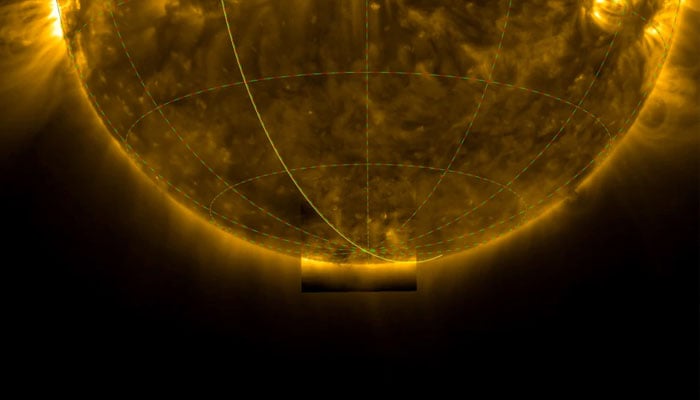European Solar Orbiter captures first glimpse of Sun's south pole
Previous close-up images of Sun have always been captured from around its equator
June 12, 2025

New images from the Solar Orbiter spacecraft have offered an unprecedented look at the Sun's south pole, revealing a turbulent and complex magnetic field as the star approaches the most active phase of its natural cycle.
These pioneering images, released on Wednesday by the European Space Agency (ESA), mark a significant leap in heliophysics, providing fresh insights into the Sun's behaviour, its magnetic field, and its role in producing space weather, NBC News reported.
"The Sun is our nearest star, giver of life and potential disruptor of modern space and ground power systems, so it is imperative that we understand how it works and learn to predict its behaviour," said Carole Mundell, director of science at ESA, in a statement.
She added that these "new unique views from our Solar Orbiter mission are the beginning of a new era of solar science."
Heliophysicists are already benefiting from the observations, which show intense magnetic activity at the south pole as the Sun gears up for its solar maximum.
The Sun's natural cycle spans approximately 11 years, transitioning from a quiet period of low magnetic activity to a highly active phase marked by powerful solar flares and storms. During the solar maximum, the Sun's magnetic poles undergo a flip, with the south pole becoming magnetic north.
While the precise reasons for this flip and its exact timing remain unclear, the Solar Orbiter's data may help unravel these mysteries.
Scientists have observed that the Sun's south pole currently exhibits a jumble of magnetic fields with both north and south polarities. This magnetic "mishmash" is expected to be temporary, lasting only during the solar maximum before the magnetic field fully flips.
Once the flip occurs, a single polarity is expected to gradually establish itself at the poles as the Sun moves towards its quieter solar minimum phase.
"How exactly this build-up occurs is still not fully understood, so Solar Orbiter has reached high latitudes at just the right time to follow the whole process from its unique and advantageous perspective," explained Sami Solanki, director of the Max Planck Institute for Solar System Research in Germany and lead scientist for Solar Orbiter's PHI instrument, which maps the Sun's surface magnetic field.
Previous close-up images of the Sun have always been captured from around its equator by spacecraft orbiting along a plane similar to Earth's. However, due to Solar Orbiter's unique trajectory, allowed the spacecraft to tilt its orbit and achieve higher-than-normal solar latitudes.
The newly released images were captured in late March, when the Solar Orbiter was positioned 15 degrees below the Sun's equator, and then a few days later at 17 degrees below the equator. This elevated perspective provided the probe with its first direct view of the Sun's south pole.
Launched in February 2020, the Solar Orbiter is a collaborative mission between the ESA and the National Aeronautics and Space Administration.









